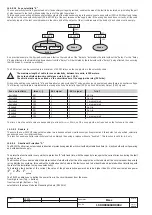
L2234
Emax
80/158
Model
Scale
Page No.
Doc. No.
Apparatus
1SDH000460R0002
L2778
14.2.9.2.3 Zone selectivity “S”
The zone selectivity function, guaranteed only if an auxiliary voltage is provided, enables the area of the fault to be isolated, only isolating the part
of plant nearest to the fault, while keeping the rest of the plant operational.
This is done by connecting all the zone selectivity outputs of the releases belonging to the same zone to one another (ZSO=K51/SZout) and taking
this signal to the zone selectivity input (ZSI=K51/SZin) of the next release on the supply side. If the wiring has been done correctly, all the zone
selectivity inputs of the last circuit-breakers in the chain and all the outputs of the circuit-breakers at the head of each chain must be empty.
14.2.9.3 Double S
Thanks to the new PR123/P release that enables two independent and simultaneously active protection S thresholds to be specified, selectivity
can assured even in critical conditions.
This function enables a better selectivity level to be obtained than using a release without a "double S". This function is valid for t=K only.
14.2.9.4
Directional Protection “D”
The PR123/P unit carries out excludable directional protection against short-circuit with adjustable fixed time (t = k) active both with self-powering
and with auxiliary supply.
The protection functionality is very similar to protection "S" with fixed time, with the capacity to recognize the current direction during the fault
period as well.
The direction of the current enables the determination of whether the fault is on the supply side or the load side of the circuit-breaker. Especially
in ring distribution systems, this enables the distribution stretch where the fault occurred to be identified and isolated without interfering with
the rest of the installation (using zone selectivity).
To determine the direction of the current, the value of the phase reactive powers has to be higher than 2% of the nominal phase power
(
P
Q
≥
2%
⋅
P
nphase
).
The PR123 enables you to define the power flow in the circuit-breaker from the menu:
from high to low (Top
→
Bottom),
from low to high (Bottom
→
Top),
selectable in the menu Modules Measuring Module (PR120/V).
As a practical example, the figure above shows a fault on the load side of the "Relay 1a" isolated by the latter without the "Relay 1" or the "Relay
0" being affected; a fault immediately downstream from the "Relay 1" will be isolated by the latter without the "Relay 0" being affected, thus ensuring
that the Areas 2...n remain operational.
The ZSO output can be connected to a maximum of 20 ZSI relays on the supply side in the selectivity chain.
The maximum length of cable for zone selectivity, between two units, is 300 meters.
Use corded shielded two-wire cable (see note A to par. 11.2.2).
The shield must only be earthed on the circuit-breaker of the supply-side relay (ZSI side).
Wiring and enabling zone selectivity "S" is an alternative to using protection "D" and operation is only guaranteed when there is an auxiliary voltage.
The following logical table is implemented to manage the Zone Selectivity Input (ZSI) and Zone Selectivity Output (ZSO) signals:
Zone selectivity
Imax > I
2
ZSI signal
ZSO signal
Trip T
Excluded
NO
0
0
No trip
Excluded
NO
1
0
No trip
Excluded
YES
0
0
t
2
programmed
Excluded
YES
1
0
t
2
programmed
Inserted
NO
0
0
No trip
Inserted
NO
1
1
No trip
Inserted
YES
0
1
t
selectivity
Inserted
YES
1
1
t
2
programmed
The time t
2
must be set at a value corresponding to at least t
selectivity
+50ms, on CB on supply side, not required on the first one in the chain.
Area 1
RELAY
1a
RELAY
1b
ZSO
ZSO
1a
1b
RELAY
1
ZSI
1
ZSO
1
Area 2
Area n
○
○
○
○
RELAY
2
ZSI
2
ZSO
2
RELAY
0
ZSI
0
RELAY
n
ZSI
n
ZSO
n
○
○
○
○
















































